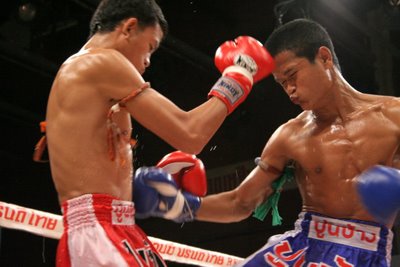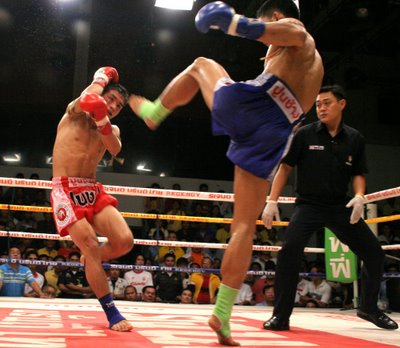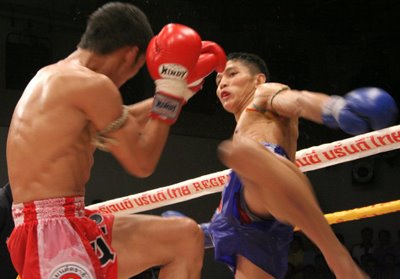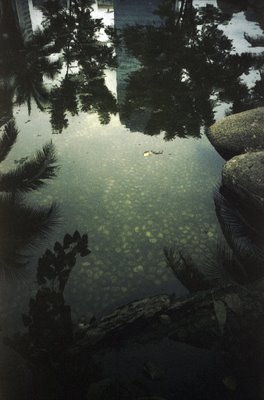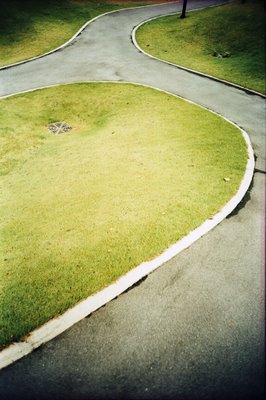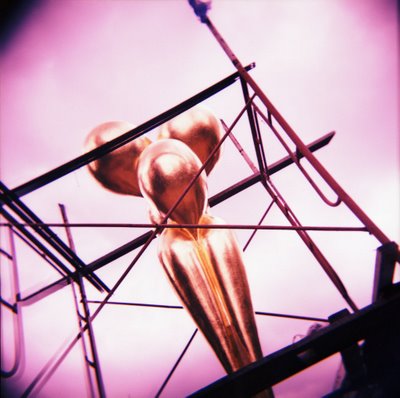Portrait of a Boxer, by Timothy Syrota

This picture is not by me, but it's now mine.
Timothy Syrota shot it, in Burma, during a bare-knuckle Thai (or, in this case, Burmese) boxing match organized by the rebel Burmese army, the DKBA (Democratic Kayin Buddhist Army). It was exposed six months ago in Bangkok, at the FCCT (Foreign Correspondant's Club of Thailand), where I first saw it and began thinking of purchasing it. I jotted down Tim's e-mail and wrote him to congratulate him on his amazing work.
"I went to your exhibit and I was blown away. Your work has created a lasting, harrowing impression on me.Tim's a busy guy but he kindly replied and I emailed him a few more times over the past months because I could never quite get his pictures out of my head. I eventually told him which picture I wanted and that I finally had the dough. He stays only in Bangkok for a few days when he does, running around to see labs, printers, and other such people. Still, he made time this morning after popping out of IQ labs to see me at the coffee shop across from my office.
I saw the exhibit as being on pain and going beyond pain, something close to sacrifice. The cover-picture's boxer, flat on his back, exuded this but also the "LV" belted boxer, with those outstretched heavily muscled arms and that hollowed, dark ribcage; his Christlike pose had something nearly satanic. The ring seemed like a dream of the unconscious boy being dragged away, and again, he made me think of a martyr.
These references are not the only thing I saw in your wonderful exhibit but I'm not writing to pose as some kind of critique so it's better I leave it at that. I'm only trying to say I was deeply impressed by your work. I really want to get a print but I have to wait a little bit.
I really look forward to your next exhibit."
At his exhibit, he had provided written labels with some information on the amazing stories behind his pictures but he kindly shared more this morning and it's fascinating stuff. Just imagine the DKBA organizing these bloody boxing matches (most matches are done without gloves, just the traditional strips of cloth wrapped around the hands) in Burma but in zones where the junta has no power. Everyone crosses in and out of there with no visa, but with permission from the rebel army. Even the Burmese military come in to watch! Rebels and minions of one of the hardest military dictatorships in the world sit side by side to enjoy this expensive (for the DKBA) and exciting event. On the surface, the fights are not really about Burmese vs. Burmese though, as they pit Burmese against Thais in an expression of the hatred that has existed between the two nations for centuries. But this is definitely a show of power for the DKBA that resonates within Burma and amongst Burmese refugees.
That's the political backdrop, but the individual stories, sometimes tragedies, that explain why someone would get his face punched to a pulp for twenty dollars are a lot more poignant. He's currently collecting more data, conducting interviews, and hopefully shooting some more for the next three months. It should all culminate in a fantastic book. At the end of the year, he'll be through with Mae Sot (the Burmese refugee camp in Thailand) after spending 2 and a half years there. He is now considering a stint in Africa before coming back to settle in SE Asia more permanently. Too bad he's out of here soon but we'll keep in touch, I'm sure.
You can see images by Tim, from "Boxing on the Border" but also of the DKBA and of his art project with refugee children on his flickr account (link).
You won't see this particular image on his flickr account. I might also be the first to buy it since I have number 1/48 (this is the copy that was exposed at FCCT). It's not one of the most striking images, and Tim didn't show it at his last exhibit in Australia but then again he was showing not just the boxing so he had to trim down on that. But this picture grew on me particularly.
Part of the reason it is so beautiful, and this goes for all Tim's pictures, you can't see on your screen. Tim has all his pictures hand-printed in Thailand by two masters in Bangkok and in Chiang Mai. I think this print was made in Chiang Mai. There's just no way you can have any idea of what this picture is about by seeing it here on a screen. A hand-made print surpasses anything you could ever get by dropping off your pictures at a lab, even if you ask for a high-quality print. Trust me, I've tried. Hand-made prints means the printer will make test-strips or even entire prints before he makes the one you eventually get to see. It's total perfection. The quality of the blacks and the tonal range is simply amazing. It's also very luminous. I tried to raise the levels on the small scan he had sent me to confirm we were talking about the same image but it just looks murky now.
As for the picture itself, I guess my first e-mail to Tim describes what I feel pretty well. Intense, dark, harrowing, with a lot of pain. I showed it around at the office, quite proud of it, and people just shrank from it and made grimaces. One asked, "You like this kind of stuff?" At first, I thought, "Oh well, they don't get it." But now I realize that they do get it, and they can't take it.
This is the first piece of art I buy, ever. I never put anything on my walls. I hardly ever print my own pictures. But this image is getting framed right now. It's 16x20", and the frame will extend 4.5" on all sides but the bottom, which will be at 5.5". Tim said that if the top and bottom are the same length, it looks as if the top is longer. I just know it will look beautiful and I will never tire of it, unlike with my own stuff.



















